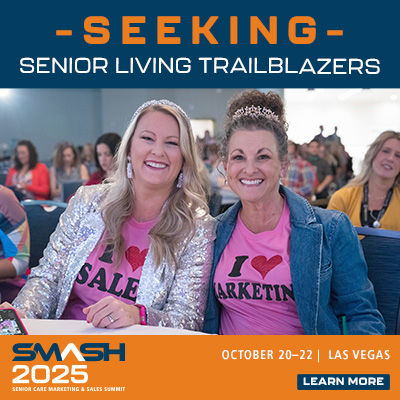By Jack Cumming
Working with a world changer can be both challenging and uplifting. I’ve been reading Walter Isaacson’s biography of Steve Jobs, and earlier, I read his biography of Elon Musk. Both men were incredibly demanding, but they had no trouble finding extraordinarily gifted people to work with. People of high talent love working in the pressure cooker of visionary change.
It’s not hard to think of opportunities to improve life. The challenge is to bring them to realization. Xerox’s Palo Alto Research Center (PARC) could have made Xerox what Apple is today. But it didn’t. Steve Jobs did. For those of us living or working in senior living, it’s similarly easy to envision improvements for those who are aging. Many of those improvements might be good for people of all ages. The hard part is to make opportunity reality.
Entrepreneurial Progress
Once upon a future time, a visionary leader emerged who changed aging and living in America forever. Since it’s the future, we can’t provide a name. Still, we do know that our future world changer will be bold, unafraid of reasoned risk, systematic in mind, and the kind of person who attracts talent. Those who are mediocre will be critical and envious. They will plod along familiar tracks even as they are superseded.
Who will be the visionary boss who succeeds in changing life in America and making old age one of the best of ages? There’s no doubt that there are innovators in senior living. People like Lynne Katzmann, Jill Vitale-Aussem, and Ryan Frederick spring to mind. Recently, I met Carl Hirschman, and he is a possible world changer. There are lots of us who are fantasy entrepreneurs, but there are precious few who actually change the world.
Breakthrough Entrepreneurs
World changers are extraordinarily self-assured, and they have an eye for talent that can help them realize their dream. What might that dream be for senior living? That has to be totally speculative, but certain things seem apparent.
- Old people don’t want to be outcasts segregated from the rest of society. Is there someone who can ameliorate the shocks of aging without taking away people’s dignity?
- The challenges of old age are worldwide. Why aren’t there trusted brands to respond globally, or even nationally, to those challenges? Surely, someone can improve on the national branding of “A Place for Mom®.”
- Then, there’s the biggie. Can anyone commit, without qualification or evasive legalizing, to assure older persons that they will be sheltered for the rest of their lives with all-inclusive services that respond to whatever life throws at them? As best we can tell, no one now lives up to that kind of commitment. If that’s impossible, how close can someone come to that ideal?
It seems evident that creating a trusted national brand is essential to unlocking the potential latent in today’s senior living. Moreover, the brand would have to meet people where they are, happily living in the wider community and wanting to stay put, while providing assurances that buying the brand will make their lives better, not worse. Trust is central and elusive.
Effective Branding
At one time, I thought that Brookdale might be that breakthrough national brand, but that didn’t happen. Acts Retirement-Life Communities seems to have the mindset, but it is handicapped by its nonprofit insistence and its conventionality. Does the entrepreneurial disruptor have to be a housing company, or could a simple services approach define the future?
Many enterprises talk about brands. Some even have contrived names (Vi, HumanGood, et al.). But successful brands are built by creative personalities working with world-class marketing geniuses, e.g., Donny Deutsch, Bill Bernbach, David Ogilvy. How did Taylor Swift become such a popular brand in such a short time?
You know it when you see it. Example: Stories of the Sharp Experience, starting in 2001 with an Episode 1 experience that tugged at one’s heartstrings and continuing to inspire staff and the public. You can imagine how each of these episodes could be repurposed for 15- or 30-second spot ads. Good national promotion of something like living has to touch hearts in much the same way that Susan Boyle’s voice does.
Outsiders vs. Insiders
It seems evident that the opportunity is there, but it would take one of those dynamic world changers to make it a reality. Since trust is what is central to senior living, any emerging brand has to have very high brand standards, even if absolute ownership and control are not essential.
At one time, LeadingAge tried to develop a trusted brand with the Continuing Care Accreditation Commission, but that effort fell short, was not well promoted, and was ultimately sold. It was also a binary rating with little consumer credibility. Obviously, the trade associations have struggled with the grassroots public. Perhaps there are too many disparate voices to allow the kind of entrepreneurial genius that a Steve Jobs, Jeff Bezos, or Andrew Carnegie might bring to the opportunity.
Learning from Hotels
Among hotel brands, Marriott emerged as a trusted, consistent brand and led the industry for many years. Marriott even dipped a toe into the senior living space but retreated, reportedly due to fear that the accidents related to the vulnerability of old people might damage the reputation of the larger brand. Frailty and decline are vulnerabilities that need to be managed and addressed openly.
To repeat, it’s not hard to imagine brand breakthroughs that could upend senior living much as the hotel industry was upended after World War II, first by Holiday Inns and then by Marriott. To do the same for senior living would require a simple, basic trust and quality pledge, enforced for franchised and direct-owned enterprises alike, with latitude for local innovation beyond the core branding. We are a nation of entrepreneurs, and innovation is central to ongoing relevance.
The opportunity is there, waiting for someone to seize it. Carl Hirschmann, and others like you, are you listening? Do you have the ambition, energy, determination, and derring-do to lead change? Change will take capital, determination, resilience, and talent.
If capital providers are too greedy, it may require grassroots funding. After all, some older people have wealth that they want to use for their latter years. It will also take a concentration of high talent and a leader capable of identifying, attracting, and motivating that team … a true team working together, not subordinates called a “team” in name only.
A little imagination, and a lot of energy and dedication can improve the lives of Americans. One day, in the not so distant future, today’s CCRCs will seem as old-fashioned as those yellowing pictures of hospital wards from long ago. Just as CCRCs are an improvement over warehousing the very old in hospital wards, tomorrow’s aging will improve on what is now commonplace.





